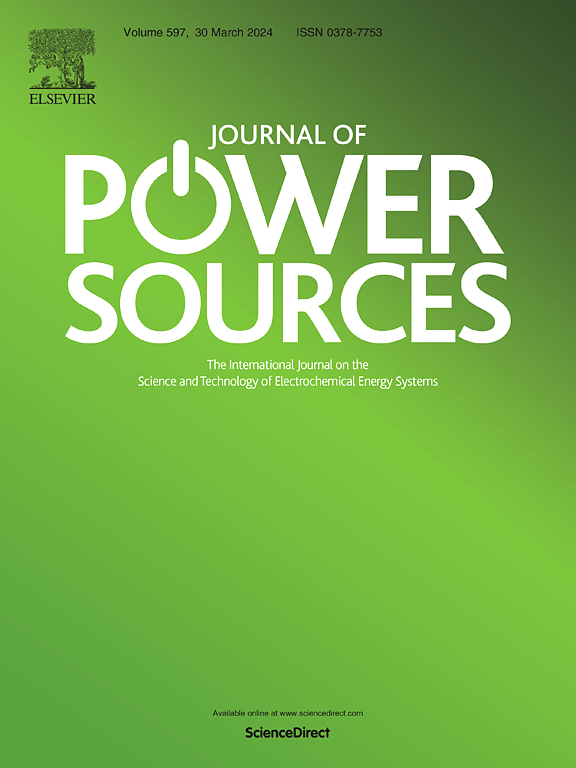Revealing the unexpected interfacial promotion effect of Cu3P on NiOx/black phosphorus for (photo-)electrocatalytic urea oxidation
IF 8.1
2区 工程技术
Q1 CHEMISTRY, PHYSICAL
引用次数: 0
Abstract
Up to now, nickel-based materials have been considered as the most promising catalysts for urea oxidation reaction (UOR). However, the inevitable self-oxidation from Ni2+ to Ni3+ severely limited their activity during UOR. To trigger the UOR occurred before self-oxidation of Ni species by altering reaction pathways, here synergistic dual-site of Cu3P-NiOx on black phosphorus (BP) nanosheets is constructed by a facile self-designed electrosynthesis method, where exfoliation of bulky BP into nanosheets and formation of multivalent Ni or Cu precursor are both obtained during electrosynthesis process. The best Cu3P-NiOx/BP shows the potential of 1.378 V under light irradiation at 10 mA cm−2 (without IR compensation), 187 mV lower than that in oxygen evolution reaction. This UOR activity of Cu3P-NiOx/BP is superior to Cu3P/BP or NiOx/BP, which is attributed to synergistic dual-site constructure of Cu3P-NiOx. In-situ and ex-situ characterizations suggest that in-situ generated Cu3P promotes adsorption and activation of urea molecules, and takes synergistic effect with NiOx, which makes urea oxidation undergoes a direct complete oxidation process. Moreover, with application of light illumination, excited photoelectrocatalytic effect by Cu3P further greatly enhances the activity for UOR. This study provides insights to the designing principles for optimizing reaction pathways toward small nucleophile molecule oxidation and effective strategies to develop efficient UOR photoelectrocatalysts.

迄今为止,镍基材料一直被认为是尿素氧化反应(UOR)中最有前途的催化剂。然而,在尿素氧化反应过程中,不可避免的从 Ni2+ 到 Ni3+ 的自氧化作用严重限制了它们的活性。为了通过改变反应途径,在镍发生自氧化之前引发尿素氧化反应,本文采用一种简便的自行设计的电合成方法,在黑磷(BP)纳米片上构建了 Cu3P-NiOx 的协同双位点。最佳的 Cu3P-NiOx/BP 在 10 mA cm-2 的光照射下(无红外补偿)显示出 1.378 V 的电位,比氧进化反应的电位低 187 mV。Cu3P-NiOx/BP 的 UOR 活性优于 Cu3P/BP 或 NiOx/BP,这归因于 Cu3P-NiOx 的协同双位结构。原位和非原位表征表明,原位生成的 Cu3P 可促进尿素分子的吸附和活化,并与 NiOx 起协同作用,从而使尿素氧化过程直接完成。此外,在光照下,Cu3P 的激发光电催化效应进一步大大提高了尿素氧化还原的活性。这项研究为优化亲核小分子氧化反应途径的设计原理和开发高效 UOR 光电催化剂的有效策略提供了启示。
本文章由计算机程序翻译,如有差异,请以英文原文为准。
求助全文
约1分钟内获得全文
求助全文
来源期刊

Journal of Power Sources
工程技术-电化学
CiteScore
16.40
自引率
6.50%
发文量
1249
审稿时长
36 days
期刊介绍:
The Journal of Power Sources is a publication catering to researchers and technologists interested in various aspects of the science, technology, and applications of electrochemical power sources. It covers original research and reviews on primary and secondary batteries, fuel cells, supercapacitors, and photo-electrochemical cells.
Topics considered include the research, development and applications of nanomaterials and novel componentry for these devices. Examples of applications of these electrochemical power sources include:
• Portable electronics
• Electric and Hybrid Electric Vehicles
• Uninterruptible Power Supply (UPS) systems
• Storage of renewable energy
• Satellites and deep space probes
• Boats and ships, drones and aircrafts
• Wearable energy storage systems
 求助内容:
求助内容: 应助结果提醒方式:
应助结果提醒方式:


